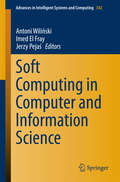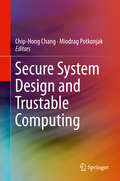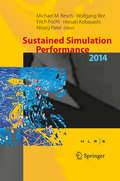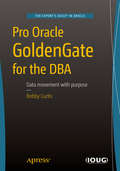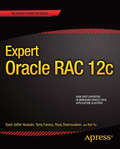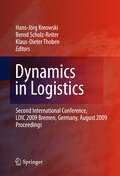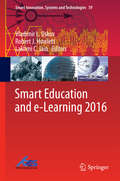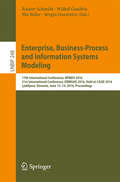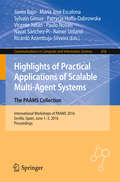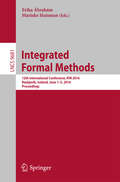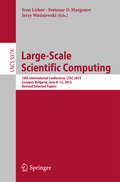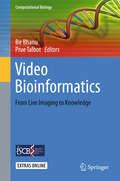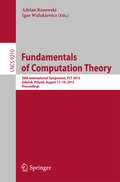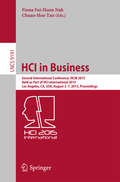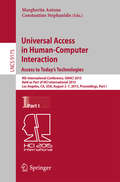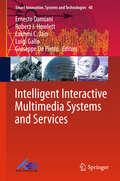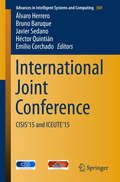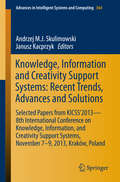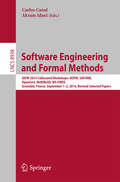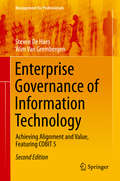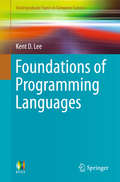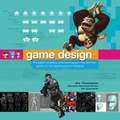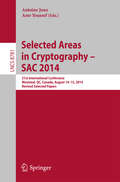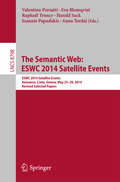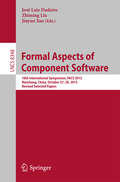- Table View
- List View
Soft Computing in Computer and Information Science
by Antoni Wiliński Imed El Fray Jerzy PejaśThis book presents a carefully selected and reviewed collection of papers presented during the 19th Advanced Computer Systems conference ACS-2014. The Advanced Computer Systems conference concentrated from its beginning on methods and algorithms of artificial intelligence. Further future brought new areas of interest concerning technical informatics related to soft computing and some more technological aspects of computer science such as multimedia and computer graphics, software engineering, web systems, information security and safety or project management. These topics are represented in the present book under the categories Artificial Intelligence, Design of Information and Multimedia Systems, Information Technology Security and Software Technologies.
Secure System Design and Trustable Computing
by Miodrag Potkonjak Chip-Hong ChangThis book provides the foundations for understanding hardware security and trust, which have become major concerns for national security over the past decade. Coverage includes issues related to security and trust in a variety of electronic devices and systems related to the security of hardware, firmware and software, spanning system applications, online transactions and networking services. This serves as an invaluable reference to the state-of-the-art research that is of critical significance to the security of and trust in, modern society's microelectronic-supported infrastructures.
Sustained Simulation Performance 2014
by Michael M. Resch Wolfgang Bez Erich Focht Hiroaki Kobayashi Nisarg PatelThis book presents the state of the art in high-performance computing and simulation on modern supercomputer architectures. It covers trends in hardware and software development in general and the future of high-performance systems and heterogeneous architectures in particular. The application-related contributions cover computational fluid dynamics, material science, medical applications and climate research; innovative fields such as coupled multi-physics and multi-scale simulations are highlighted. All papers were chosen from presentations given at the 18th Workshop on Sustained Simulation Performance held at the HLRS, University of Stuttgart, Germany in October 2013 and subsequent Workshop of the same name held at Tohoku University in March 2014.
Pro Oracle GoldenGate for the DBA
by Bobby CurtisThis book provides a simple approach to learning the Oracle GoldenGate product. This approach provides the in-depth perspective of GoldenGate from an implementer's viewpoint; however, also addresses why the management viewpoint is important as well. Your journey through this book includes and architecture discussion of GoldenGate and the benefits of purchasing GoldenGate from a management perspective. Then the book quickly moves into advanced implementation components associated with GoldenGate. You'll find many use-cases and instructions throughout the book to help with everything from easy to complex GoldenGate implementations. An Oracle GoldenGate implementation generally consists of a group project, involving both business and technical resources. Pro Oracle GoldenGate for the DBA provides the viewpoint from the DBA's vantage point. This approach provides the components of who, what, why, when, and how in defining the implementation and support of a GoldenGate project. The success of most technical projects require the support of multiple resource groups, and Pro Oracle GoldenGate for the DBA supplies the insight for the DBA member to understand the implementation and support process. Takes you through justification, installation, and support. Provides the DBA perspective toward a successful a result. Covers from basic toward increasingly advanced implementations What you'll learn Understand the core architecture of data replication using Oracle GoldenGate Implement a one-way setup of a classic capture and an integrated capture and replication Design, architect and implement a multi-master replication model Perform heterogeneous replication processes between multiple database architectures Replicate unsupported data types using tokens Manage and troubleshoot multiple GoldenGate implementations New features of GoldenGate supported in Oracle 12c Who this book is for Pro Oracle GoldenGate for the DBA is aimed squarely at Oracle database administrators who find themselves involved in GoldenGate integration projects. The book provides the DBA view into such projects, helping database administrators toward successful implementations and solid business results.
Expert Oracle RAC 12c
by Riyaj Shamsudeen Syed Jaffar Hussain Tariq Farooq Kai YuExpert Oracle RAC 12c is a hands-on book helping you understand and implement Oracle Real Application Clusters (RAC), and to reduce the total-cost-of-ownership (TCO) of a RAC database. As a seasoned professional, you are probably aware of the importance of understanding the technical details behind the RAC stack. This book provides deep understanding of RAC concepts and implementation details that you can apply toward your day-to-day operational practices. You'll be guided in troubleshooting and avoiding trouble in your installation. Successful RAC operation hinges upon a fast-performing network interconnect, and this book dedicates a chapter solely to that very important and easily overlooked topic. All four authors are experienced RAC engineers with a wealth of hard-won experience encountering and surmounting the challenges of running a RAC environment that delivers on its promise. In Expert Oracle RAC 12c they provide you a framework in which to avoid repeating their hard-won lessons. Their goal is for you to manage your own RAC environment with ease and expertise. Provides a deep conceptual understanding of RAC Provides best practices to implement RAC properly and match application workload Enables readers to troubleshoot RAC with ease What you'll learn Know when to apply RAC, and when not to Design applications to take advantage of RAC Troubleshoot and solve clusterware problems Manage database backup and recovery in RAC Stay on top of locking issues and deadlock detection Harness the performance from parallel processing in RAC Support your RAC environment with a healthy network interconnect Who this book is for Expert Oracle RAC 12c is for experienced Oracle Database Administrators (DBAs) who are ready to take the next step in their career by expanding their skill set to include building and managing Oracle Real Application Clusters (RAC). DBAs and architects who are in the process of implementing RAC can immensely benefit from this book. It's an excellent choice for DBAs to learn RAC conceptually, understand best practices, and become experts in troubleshooting RAC problems. Table of Contents Overview of Oracle RAC Clusterware Management and Troubleshooting RAC Operational Practices RAC New Features Storage and ASM Practices Application Design Issues Managing and Optimizing a Complex RAC Environment Backup and Recovery in RAC Network Practices in RAC RAC Database Optimization Locks and Deadlocks Parallel Query in RAC Clusterware and Database Upgrades Oracle RAC One Node
Dynamics in Logistics
by Bernd Scholz-Reiter Hans-Jörg Kreowski Klaus-Dieter ThobenThe volume comprises the proceedings of the third International Conference on Dynamics in Logistics LDIC 2012. The scope of the conference targeted the identification, analysis, and description of the dynamics of logistic processes and networks. The spectrum ranged from the modeling and planning of processes and innovative methods like autonomous control and knowledge management to the new technologies provided by radio frequency identification, mobile communication, and networking. The growing dynamics in the area of logistics poses completely new challenges: Logistic processes and networks must rapidly and flexibly adapt to continuously changing conditions. LDIC 2012 provided a venue for researchers from academia and industry interested in the technical advances in dynamics in logistics. The conference addressed research in logistics from a wide range of fields, e.g. engineering, computer science and operations research. The volume consists of two invited papers and of 49 contributed papers divided into various subjects including transport logistics, routing in dynamic logistic networks, modeling, simulation, optimization and collaboration in logistics, identification technologies, mathematical modeling in transport and production logistics, information, communication, risk and failure in logistic systems, autonomous control in logistic processes, global supply chains and industrial applications, and the Internet of Things in the context of logistics.
Smart Education and e-Learning 2016
by Lakhmi C. Jain Robert J. Howlett Vladimir L. UskovThis book contains the contributions presented at the 3rd international KES conference on Smart Education and Smart e-Learning, which took place in Puerto de la Cruz, Tenerife, Spain, June 15-17, 2016. It contains a total of 56 peer-reviewed book chapters that are grouped into several parts: Part 1 - Smart University: Conceptual Modeling, Part 2 - Smart Education: Research and Case Studies, Part 3 - Smart e-Learning, Part 4 - Smart Education: Software and Hardware Systems, and Part 5 - Smart Technology as a Resource to Improve Education and Professional Training. We believe that the book will serve as a useful source of research data and valuable information for faculty, scholars, Ph. D. students, administrators, and practitioners - those who are interested in innovative areas of smart education and smart e-learning.
Enterprise, Business-Process and Information Systems Modeling
by Rainer Schmidt Wided Guédria Ilia Bider Sérgio GuerreiroThis book contains the refereed proceedings of the 17th International Conference on Business Process Modeling, Development and Support, BPMDS 2016, and the 21st International Conference on Exploring Modeling Methods for Systems Analysis and Design, EMMSAD 2016, held together with the 28th International Conference on Advanced Information Systems Engineering (CAiSE 2016) in Ljubljana, Slovenia, in June 2016. The focus theme for BPMDS 2016 papers was "Business Processes in a Connected World", for which three subthemes were identified: business processes for connecting people, connecting intelligent objects to business processes and connecting information/data/knowledge to business processes. The 17 full and 1 short paper accepted for BPMDS were selected from 48 submissions and are grouped into topical sections on process execution support; improving usability of process models; social and human perspectives; new directions in process modeling; consistency, correctness and compliance; process and data mining; and process variability. The intention of EMMSAD is to solicit papers related to the field of information systems analysis and design including numerous information modeling methods and notations that are typically evolving. These ongoing changes significantly impact the way information systems, enterprises, and business processes are being analyzed and designed in practice. The 12 full papers accepted for EMMSAD were chosen from 19 submissions and are grouped into topical sections on fundamental issues in modeling; requirements and regulations; enterprise and software ecosystem modeling; information and process model quality; meta-modeling and domain specific modeling and model composition; and modeling of architecture and design.
Highlights of Practical Applications of Scalable Multi-Agent Systems. The PAAMS Collection
by Paulo Novais Javier Bajo María José Escalona Sylvain Giroux Patrycja Hoffa-Dąbrowska Vicente Julián Nayat Sánchez-Pi Rainer Unland Ricardo Azambuja-SilveiraThis book constitutes the refereed proceedings of the seven workshops co-located with the 14th International Conference on Practical Applications of Agents and Multi-Agent Systems, PAAMS 2016, held in Sevilla, Spain, in June 2016. The 37 full papers presented were carefully reviewed and selected from 77 submissions. The volume presents the papers that have been accepted for the following workshops: Workshop on Agents and Multi-Agent Systems for AAL and e-Health; Workshop on Agent-Based Solutions for Manufacturing and Supply Chain; Workshop on MAS for Complex Networks and Social Computation; Workshop on Decision Making in Dynamic Information Environments; Workshop on Intelligent Systems for Context-based Information Fusion; Workshop on Multi-Agent based Applications for Smart Grids and Sustainable Energy Systems; Workshop on Multiagent System based Learning Environments.
Integrated Formal Methods
by Erika Ábrahám Marieke HuismanThis bookconstitutes the refereed proceedings of the 12th International Conference on IntegratedFormal Methods, IFM 2016, held in Reykjavik, Iceland, in June 2016. The 33 paperspresented in this volume were carefully reviewed and selected from 99submissions. They were organized in topical sections named: invitedcontributions; program verification; probabilistic systems; concurrency; safetyand liveness; model learning; SAT and SMT solving; testing; theorem proving andconstraint satisfaction; case studies.
Large-Scale Scientific Computing
by Svetozar D. Margenov Ivan Lirkov Jerzy WaśniewskiThis book constitutes the thoroughly refereedpost-conference proceedings of the 10th International Conference on Large-ScaleScientific Computations, LSSC 2015, held in Sozopol, Bulgaria, in June 2015. The 49 revised full papers presented were carefullyreviewed and selected from 64 submissions. The general theme for LSSC 2015 wasLarge-Scale Scientific Computing with a particular focus on the organizedspecial sessions: enabling exascale computation; control and uncertain systems;computational microelectronics - from monte carlo to deterministic approaches;numerical methods for multiphysics problems; large-scale models: numericalmethods, parallel computations and applications; mathematical modeling andanalysis of PDEs describing physical problems; a posteriori error control anditerative methods for maxwell type problems; efficient algorithms for hybridHPC systems; multilevel methods on graphs; and applications of metaheuristicsto large-scale problems.
Video Bioinformatics
by Bir Bhanu Prue TalbotThe advances of live cell video imaging and high-throughput technologies for functional and chemical genomics provide unprecedented opportunities to understand how biological processes work in subcellular and multicellular systems. The interdisciplinary research field of Video Bioinformatics is defined by Bir Bhanu as the automated processing, analysis, understanding, data mining, visualization, query-based retrieval/storage of biological spatiotemporal events/data and knowledge extracted from dynamic images and microscopic videos. Video bioinformatics attempts to provide a deeper understanding of continuous and dynamic life processes. Genome sequences alone lack spatial and temporal information, and video imaging of specific molecules and their spatiotemporal interactions, using a range of imaging methods, are essential to understand how genomes create cells, how cells constitute organisms, and how errant cells cause disease. The book examines interdisciplinary research issues and challenges with examples that deal with organismal dynamics, intercellular and tissue dynamics, intracellular dynamics, protein movement, cell signaling and software and databases for video bioinformatics. Topics and Features * Covers a set of biological problems, their significance, live-imaging experiments, theory and computational methods, quantifiable experimental results and discussion of results. * Provides automated methods for analyzing mild traumatic brain injury over time, identifying injury dynamics after neonatal hypoxia-ischemia and visualizing cortical tissue changes during seizure activity as examples of organismal dynamics * Describes techniques for quantifying the dynamics of human embryonic stem cells with examples of cell detection/segmentation, spreading and other dynamic behaviors which are important for characterizing stem cell health * Examines and quantifies dynamic processes in plant and fungal systems such as cell trafficking, growth of pollen tubes in model systems such as Neurospora Crassa and Arabidopsis * Discusses the dynamics of intracellular molecules for DNA repair and the regulation of cofilin transport using video analysis * Discusses software, system and database aspects of video bioinformatics by providing examples of 5D cell tracking by FARSIGHT open source toolkit, a survey on available databases and software, biological processes for non-verbal communications and identification and retrieval of moth images This unique text will be of great interest to researchers and graduate students of Electrical Engineering, Computer Science, Bioengineering, Cell Biology, Toxicology, Genetics, Genomics, Bioinformatics, Computer Vision and Pattern Recognition, Medical Image Analysis, and Cell Molecular and Developmental Biology. The large number of example applications will also appeal to application scientists and engineers. Dr. Bir Bhanu is Distinguished Professor of Electrical & C omputer Engineering, Interim Chair of the Department of Bioengineering, Cooperative Professor of Computer Science & Engineering, and Mechanical Engineering and the Director of the Center for Research in Intelligent Systems, at the University of California, Riverside, California, USA. Dr. Prue Talbot is Professor of Cell Biology & Neuroscience and Director of the Stem Cell Center and Core at the University of California Riverside, California, USA.
Fundamentals of Computation Theory
by Adrian Kosowski Igor WalukiewiczThis book constitutes the refereed proceedings of the 20th International Symposium on Fundamentals of Computation Theory, FCT 2015, held in Gdańsk, Poland, in August 2015. The 27 revised full papers presented were carefully reviewed and selected from 60 submissions. The papers cover topics in three main areas: algorithms, formal methods, and emerging fields and are organized in topical sections on geometry, combinatorics, text algorithms; complexity and Boolean functions; languages; set algorithms, covering, and traversal; graph algorithms and networking applications; anonymity and indistinguishability; graphs, automata, and dynamics; and logic and games.
HCI in Business
by Fiona Fui-Hoon Nah Chuan-Hoo TanThis volume constitutes the refereed proceedings of the Second International Conference on HCI in Business, HCIB 2015, held as part of the 17th International Conference on Human-Computer Interaction, HCII 2015, which took place in Los Angeles, CA, USA, in August 2015. HCII 2015 received a total of 4843 submissions, of which 1462 papers and 246 posters were accepted for publication after a careful reviewing process. The papers address the latest research and development efforts and highlight the human aspects of design and use of computing systems. They thoroughly cover the entire field of human-computer interaction, addressing major advances in knowledge and effective use of computers in a variety of application areas. The 72 papers presented in this volume address the following topics: social media for business, enterprise systems, business and gamification, analytics, visualization and decision- making, industry, academia, innovation, and market.
Universal Access in Human-Computer Interaction. Access to Today's Technologies
by Margherita Antona Constantine StephanidisThe four LNCS volume set 9175-9178 constitutes the refereed proceedings of the 9th International Conference on Learning and Collaboration Technologies, UAHCI 2015, held as part of the 17th International Conference on Human-Computer Interaction, HCII 2015, in Los Angeles, CA, USA in August 2015, jointly with 15 other thematically similar conferences. The total of 1462 papers and 246 posters presented at the HCII 2015 conferences were carefully reviewed and selected from 4843 submissions. These papers of the four volume set address the following major topics: LNCS 9175, Universal Access in Human-Computer Interaction: Access to today's technologies (Part I), addressing the following major topics: LNCS 9175: Design and evaluation methods and tools for universal access, universal access to the web, universal access to mobile interaction, universal access to information, communication and media. LNCS 9176: Gesture-based interaction, touch-based and haptic Interaction, visual and multisensory experience, sign language technologies, and smart and assistive environments LNCS 9177: Universal Access to Education, universal access to health applications and services, games for learning and therapy and cognitive disabilities and cognitive support and LNCS 9178: Universal access to culture, orientation, navigation and driving, accessible security and voting, universal access to the built environment and ergonomics and universal access.
Intelligent Interactive Multimedia Systems and Services
by Lakhmi C. Jain Robert J. Howlett Ernesto Damiani Luigi Gallo Giuseppe De PietroIntelligent interactive multimedia systems and services will be ever more important in computer systems. Nowadays, computers are widespread and computer users range from highly qualified scientists to non-computer expert professionals. Therefore, designing dynamic personalization and adaptivity methods to store, process, transmit and retrieve information is critical for matching the technological progress with the consumer needs. This book contains the contributions presented at the eighth international KES conference on Intelligent Interactive Multimedia: Systems and Services, which took place in Sorrento, Italy, June 17-19, 2015. It contains 33 peer-reviewed scientific contributions that focus on issues ranging from intelligent image or video storage, retrieval, transmission and analysis to knowledge-based technologies, from advanced information technology architectures for video processing and transmission to advanced functionalities of information and knowledge-based services. We believe that this book will serve as a useful source of knowledge for both academia and industry, for all those faculty members, research scientists, scholars, Ph. D. students and practitioners, who are interested in fundamental and applied facets of intelligent interactive multimedia.
International Joint Conference
by Bruno Baruque Álvaro Herrero Javier Sedano Héctor Quintián Emilio CorchadoThis volume of Advances in Intelligent and Soft Computing contains accepted papers presented at the 8th International Conference on Computational Intelligence in Security for Information Systems (CISIS 2015) and the 6th International Conference on European Transnational Education (ICEUTE 2015). These conferences were held in the beautiful and historic city of Burgos (Spain), in June 2015. The aim of the 8th CISIS conference is to offer a meeting opportunity for academic and industry-related researchers belonging to the various, vast communities of Computational Intelligence, Information Security, and Data Mining. The need for intelligent, flexible behaviour by large, complex systems, especially in mission-critical domains, is intended to be the catalyst and the aggregation stimulus for the overall event. After a through peer-review process, the CISIS 2015 International Program Committee selected 43 papers, written by authors from 16 different countries. In the case of 6th ICEUTE conference, the International Program Committee selected 12 papers (from 7 countries). These papers are published in present conference proceedings, achieving an acceptance rate of about 39%. The selection of papers was extremely rigorous in order to maintain the high quality of the conference and we would like to thank the members of the Program Committees for their hard work in the reviewing process. This is a crucial process to the creation of a high standard conference and the CISIS and ICEUTE conferences would not exist without their help.
Knowledge, Information and Creativity Support Systems: Recent Trends, Advances and Solutions
by Janusz Kacprzyk Andrzej M.J. SkulimowskiThis volume contains some carefully selected papers presented at the 8th International Conference on Knowledge, Information and Creativity Support Systems KICCS'2013, which was held in Kraków and Wieliczka, Poland in November 2013. In most cases the papers are extended versions with newer results added, representing virtually all topics covered by the conference. The KICCS'2013 focus theme, "Looking into the Future of Creativity and Decision Support Systems", clearly indicates that the growing complexity calls for some deeper and insightful discussions about the future but, obviously, complemented with an exposition of modern present developments that have proven their power and usefulness. Following this theme, the list of topics presented in this volume include some future-oriented fields of research, such as anticipatory networks and systems, foresight support systems, relevant newly-emerging applications, exemplified by autonomous creative systems. Special attention was also given to cognitive and collaborative aspects of creativity.
Software Engineering and Formal Methods
by Carlos Canal Akram IdaniThis book constitutes revised selected papers from the workshops collocated with the SEFM 2014 conference on Software Engineering and Formal Methods, held in Grenoble, France, in September 2014. The 26 papers included in this volume were carefully reviewed and selected from 49 submissions. They are from the following workshops: the 1st Workshop on Human-Oriented Formal Methods - From Readability to Automation, HOFM 2014, the 3rd International Symposium on Modelling and Knowledge Management Applications - Systems and Domains, MoKMaSD 2014, the 8th International Workshop on Foundations and Techniques for Open Source Software Certification, Open Cert 2014, the 1st Workshop on Safety and Formal Methods, SaFoMe 2014 and the 4th Workshop on Formal Methods in the Development of Software, WS-FMDS 2014.
Enterprise Governance of Information Technology
by Steven Haes Wim GrembergenFeaturing numerous case examples from companies around the world, this second edition integrates theoretical advances and empirical data with practical applications, including in-depth discussion on the COBIT 5 framework which can be used to build, measure and audit enterprise governance of IT approaches. At the forefront of the field, the authors of this volume draw from years of research and advising corporate clients to present a comprehensive resource on enterprise governance of IT (EGIT). Information technology (IT) has become a crucial enabler in the support, sustainability and growth of enterprises. Given this pervasive role of IT, a specific focus on EGIT has arisen over the last two decades, as an integral part of corporate governance. Going well beyond the implementation of a superior IT infrastructure, enterprise governance of IT is about defining and embedding processes and structures throughout the organization that enable boards and business and IT people to execute their responsibilities in support of business/IT alignment and value creation from their IT-enabled investments. Featuring a variety of elements, including executive summaries and sidebars, extensive references and questions and activities (with additional materials available on-line), this book will be an essential resource for professionals, researchers and students alike
Foundations of Programming Languages
by Kent D. LeeThis clearly written textbook introduces the reader to the three styles of programming, examining object-oriented/imperative, functional, and logic programming. The focus of the text moves from highly prescriptive languages to very descriptive languages, demonstrating the many and varied ways in which we can think about programming. Designed for interactive learning both inside and outside of the classroom, each programming paradigm is highlighted through the implementation of a non-trivial programming language, demonstrating when each language may be appropriate for a given problem. Features: includes review questions and solved practice exercises, with supplementary code and support files available from an associated website; provides the foundations for understanding how the syntax of a language is formally defined by a grammar; examines assembly language programming using CoCo; introduces C++, Standard ML, and Prolog; describes the development of a type inference system for the language Small.
Game Design: Principles, Practice, and Techniques - The Ultimate Guide for the Aspiring Game Designer
by Jim Thompson Barnaby Berbank-Green Nic CusworthPractical, complete coverage of game design basics from design process to production This full-color, structured coursebook offers complete coverage of game design basics, focusing on design rather than computer programming. Packed with exercises, assignments, and step-by-step instructions, it starts with an overview of design theory, then progresses to design processes, and concludes with coverage of design production. Jim Thompson, Barnaby Berbank-Green, and Nic Cusworth (London, UK) are computer game designers and lecturers in animation and computer game design.
Selected Areas in Cryptography -- SAC 2014
by Antoine Joux Amr YoussefThis book constitutes the proceedings of the 21st International Conference on Selected Areas in Cryptography, SAC 2014, held in Montreal, QC, Canada, in August 2014. The 22 papers presented in this volume were carefully reviewed and selected from 103 submissions. There are four areas covered at each SAC conference. The three permanent areas are: design and analysis of symmetric key primitives and cryptosystems, including block and stream ciphers, hash function, MAC algorithms, cryptographic permutations, and authenticated encryption schemes; efficient implementations of symmetric and public key algorithms; mathematical and algorithmic aspects of applied cryptology. This year, the fourth area for SAC 2014 is: algorithms for cryptography, cryptanalysis and their complexity analysis.
The Semantic Web: ESWC 2014 Satellite Events
by Raphael Troncy Harald Sack Valentina Presutti Anna Tordai Eva Blomqvist Ioannis PapadakisThis book constitutes the thoroughly refereed post-conference proceedings of the Satellite Events of the 11th International Conference on the Semantic Web, ESWC 2014, held in Anissaras, Crete, Greece, in May 2014. The volume contains 20 poster and 43 demonstration papers, selected from 113 submissions, as well as 12 best workshop papers selected from 60 papers presented at the workshop at ESWC 2014. Best two papers from AI Mashup Challenge are also included. The papers cover various aspects of the Semantic Web.
Formal Aspects of Component Software
by Zhiming Liu José Luiz Fiadeiro Jinyun XueThis book constitutes the revised selected papers of the 10th International Symposium on Formal Aspects of Component Software, FACS 2013, held in Nanchang, China, in October 2013. The 19 full papers and three invited talks presented were carefully reviewed and selected from 51 submissions. The papers are concerned with how formal methods can be used to make component-based development fit for the new architectures of today and the systems that are now pervading the socio-economic worlds.
